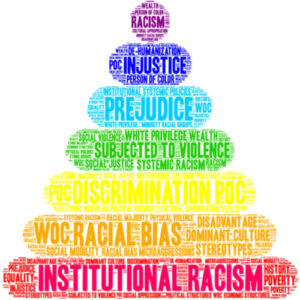Is Institutional Racism a Real Thing?
Social Work and institutional racism explain this structural racism at the level of publicly accepted institutions, like schools, hospitals, and governments. Racism relies on subtlety to survive. Like an antibiotic-resistant infection, racism evolves every time it is legislated against, publicly condemned, and policed. Each time this happens, i.e., emancipation, Brown vs. Board of Education, the Civil Rights Movement, etc., racist ideologies simply recycle themselves into less obvious “strains” for survival purposes. Even today, Ku Klux Klan members groom themselves as non-violent defenders of “white civil rights,” despite their history of senseless hate crimes.
When people fail to recognize the above distinction, they may be misled into believing that racism is no longer prevalent. Oftentimes, people will argue that racism is no longer prevalent because minorities are allegedly protected under the same laws that whites are. Jim Crow is over, and the playing field is level, so say the skeptics. Even if instances of hate crime were eradicated, which they haven’t been, this argument is flawed in its failure to acknowledge the much more subtle and powerful forms of institutional racism that persist today.
What Is Institutional Racism?
Also referred to as “structural racism,” institutional racism is that which takes place at the level of publicly accepted institutions, like banks, schools, hospitals, and entire governments. Here’s the difference between personal and institutional racism:
Personal – A black family is physically attacked and terrorized by a hate group, or they’re kicked out of a shop.
Institutional – A black family loses an infant to an easily curable disease because they could only afford to go to the free clinics surrounding their neighborhood.
It’s easy to condemn personal racism, per above, but institutional racism is written off as “the way things are.” This is why institutional racism is so much more potent; it represents the resource inequality built into America’s very infrastructure.
How Racism Impacts Major Industries
Social workers who are sensitive to how institutions discriminate against minority populations can better provide their clients with the resources they need to combat these disparities. The following industries and social opportunities are all deeply influenced by institutional racism.
Healthcare
Black people in America experience higher disease and mortality rates, dying at a younger age than white people. Similarly, Native Americans and Alaska Natives experience the same disparity in access to and quality of healthcare. This study on institutionalized racism in healthcare practice describes how these disparities are explained away, as critics cite biological and behavioral differences as more likely causes for the health gap. Both theories have been debunked with objective data.
Wealth
Even more complex than the moving parts involved in the health gap (discriminatory practices by insurance companies, state/federal legislation, etc.,) is the issue of the wealth gap. The New York Times reports that for every $100 a white family has, a black family has $5.04. Discriminatory housing practices during the Jim Crow era played a pivotal role in creating this disparity. Before the Civil Rights Act of 1964, the government would intentionally deny loans to people from low-income neighborhoods. In turn, housing developers echoed this mentality.
Employment
Anyone who has applied for a job likely remembers the nondiscrimination policy, stating some version of, “We do not discriminate based on age, gender, or sexual orientation. This legislation helps offer recourse to applicants who feel discriminated against. However, what does it do for people who are already hired? You can’t sue someone for being repeatedly passed over for a promotion. Similarly, it’s very difficult to discern whether or not an applicant was indeed discriminated against because hiring managers can simply argue for the higher suitability of another candidate – whether real or manufactured.
Criminal Justice
The controversial shootings that have dominated news cycles throughout the past decade are but a minuscule example of the systemic racism within the US Justice System. Like the wealth gap, this issue is also marked by a complex spectrum of cultural and societal elements. The fact that minorities are stopped and searched far more often than their white counterparts, however, hints strongly at institutional racism as a major player in this over-representation.
Education
If a minority group is to overcome the above obstacles, they must receive a quality education. Unfortunately, the education sector is fraught with instances of systemic inequality as well. Historically, schools with a large minority population receive less funding than schools with a majority of white students. IQ and standardized testing measure intelligence on a linear scale without acknowledging cultural differences. Students deemed less capable via these tests are often separated into a lower “track,” where educational resources are more limited.
Institutional racism is not only still a thing, it is a thing. It is part of America’s foundation and we cannot circumvent it without thoughtful reform. Social workers and the organizations they represent can take part in movements to eliminate opportunities for institutional racism. This effort can take place on a personal level, as between a social worker and their client. Let’s take a look at examples of each.
How to Fight Institutional Racism
On a societal level, social workers and the organizations they represent can promote policies, people, and groups that seek to target discriminatory practices like those mentioned above. Educational initiatives for low-income students, employment training programs for minorities, and legal protection for victims of discrimination are all ideal opportunities to decrease resource distribution disparities amongst minority groups.
Social workers can apply these efforts on a smaller scale to help their clients overcome systemic racism. Connecting the client with free or reduced-cost healthcare, education, and legal assistance programs in their area, for example, will help to decrease the resource gap. To address these gaps, of course, social workers must first appreciate that they are there. Institutional racism is a real thing, and without reform, it will continue to thrive.
Related:


